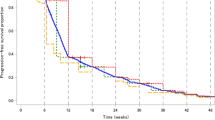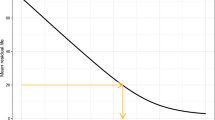Abstract
The class of semiparametric or transformation models has been presented in the literature as a promising alternative for the analysis of lifetime data in the presence of covariates and censored data. This class of models generalizes the popular class of proportional hazards models proposed by Cox (J R Stat Soc: Ser B (Methodol) 34(2):187–202, 1972) where it is not needed to assume a parametric probability distribution for the survival times. In addition to our focus on semipametric models, we also explore the situation where the population of interest is a mixture of susceptible individuals, who experience the event of interest and non-susceptible individuals that will never experience the event of interest. These individuals are not at risk with respect to the event of interest and are considered immune, non-susceptible, or cured. In this study, we present a simple method to obtain inferences for the parameters of semiparametric or transformation models in the presence of censoring, covariates and cure fraction under a Bayesian approach assuming the unknown hazard rates as latent variables with a given probability distribution. The posterior summaries of interest are obtained using existing Markov Chain Monte Carlo (MCMC) simulation methods. Some applications with real medical survival data illustrate the proposed methodology.




Similar content being viewed by others
References
Abramowitz M, Stegun IA (1972) Handbook of mathematical functions with formulas, graphs, and mathematical tables. National Bureau of Standards Applied Mathematics series 55. tenth printing
Achcar JA, Coelho-Barros EA, Mazucheli J (2012) Cure fraction models using mixture and non-mixture models. Tatra Mt Math Publ 51(1):1–9
Aitkin M (1991) Posterior Bayes factors. J Roy Stat Soc: Ser B (Methodol) 53(1):111–128
Bennett S (1983) Analysis of survival data by the proportional odds model. Stat Med 2(2):273–277
Bernardo JM, Smith AF (2009) Bayesian theory. Wiley, London
Berry DA, Berry DA (1996) Statistics: a Bayesian perspective. Duxbury Press Belmont, CA
Box GE, Tiao GC (2011) Bayesian inference in statistical analysis. Wiley, London
Brooks SP, Gelman A (1998) General methods for monitoring convergence of iterative simulations. J Comput Graph Stat 7(4):434–455
Brooks SP, Roberts GO (1998) Convergence assessment techniques for Markov Chain Monte Carlo. Stat Comput 8:319–335
Brooks SP, Roberts GO (1999) Miscellanea on quantile estimation and Markov Chain Monte Carlo convergence. Biometrika 86(3):710–717
Carlin BP, Louis TA (2008) Bayesian methods for data analysis. CRC Press
Chen Jin Z, Ying Z (2002) Semiparametric analysis of transformation models with censored data. Biometrika 89(3):659–668
Chen Lin D, Zeng D (2012) Checking semiparametric transformation models with censored data. Biostatistics 13(1):18–31
Chib S, Greenberg E (1995) Understanding the Metropolis–Hastings algorithm. Am Stat 49(4):327–335
Cowles MK, Carlin BP (1996) Markov Chain Monte Carlo convergence diagnostics: a comparative review. J Am Stat Assoc 91(434):883–904
Cox DR (1972) Regression models and life-tables. J R Stat Soc: Ser B (Methodol) 34(2):187–202
Cox DR (1975) Partial likelihood. Biometrika 62(2):269–276
Cox DR, Oakes D (1984) Analysis of survival data. Chapman and Hall, New York
Demarqui FN, Mayrink VD, Ghosh SK (2019) An unified semiparametric approach to model lifetime data with crossing survival curves. arXiv preprint arXiv:1910.04475
Farewell VT (1982) The use of mixture models for the analysis of survival of survival data with long-term survivors. Biometrics 38(4):1041–1046
Freireich B, J E, Gehan E, et al (1963) The effect of 6-mercaptopurine on the duration of steroid-induced remissions in acute leukemia: a model for evaluation of other potentially useful therapy. Blood 21(6):699–716
Gao F, Zeng D, Lin DY (2018) Semiparametric regression analysis of interval-censored data with informative dropout. Biometrics 74(4):1213–1222
Gelfand AE, Smith AF (1990) Sampling-based approaches to calculating marginal densities. J Am Stat Assoc 85(410):398–409
Gelman A, Rubin DB (1992) Inference from iterative simulation using multiple sequences. Stat Sci 7(4):457–472
Gelman A, Carlin JB, Stern HS, et al (1995) Bayesian data analysis. Chapman and Hall/CRC
Geweke J (1992) Evaluating the accuracy of sampling-based approaches to the calculations of posterior moments. Bayesian Stat 4:641–649
Gilks WR, Richardson E, Spiegelhalter DJ (1996) Markov Chain Monte Carlo in Practice. Chapman and Hall/CRC
Grambsch PM, Therneau TM (1994) Proportional hazards tests and diagnostics based on weighted residuals. Biometrika 81(3):515–526
Guo S, Zeng D (2014) An overview of semiparametric models in survival analysis. J Stat Plan Inference 151:1–16
He W, Yi GY (2020) Parametric and semiparametric estimation methods for survival data under a flexible class of models. Lifetime Data Anal 26:369–388
Kalbfleisch JD, Prentice RL (2011) The statistical analysis of failure time data. Wiley, London
Kaplan EL, Meier P (1958) Nonparametric estimation from incomplete observations. J Am Stat Assoc 53(282):457–481
Kass RE, Carlin BP, Gelman A et al (1998) Markov chain monte carlo in practice: a roundtable discussion. Am Stat 52(2):93–100
Klein JP, Moeschberger ML (2003) Survival analysis: techniques for censored and truncated data. Springer, Berlin
Lai CD, Lai CD (2014) Generalized Weibull distributions. Springer, Berlin
Lambert PC (2007) Modeling of the cure fraction in survival studies. Stand Genomic Sci 7(3):351–375
Lambert PC, Thompson JR, Weston CL et al (2007) Estimating and modeling the cure fraction in population-based cancer survival analysis. Biostatistics 8(3):576–594
Lawless JF (1982) Statistical model and method for lifetime data. Willey: London
Lee ET, Wang J (2003) Statistical methods for survival data analysis. Wiley, London
Lee PM (2012) Bayesian statistics: an introduction. Fourth Edition. Wiley, London
Li J, Yu T, Lv J et al (2021) Semiparametric model averaging prediction for lifetime data via hazards regression. J R Stat Soc: Ser C: Appl Stat 70(5):1187–1209
Lin Ying Z (1994) Semiparametric analysis of the additive risk model. Biometrika 81(1):61–71
Lin Wei LJ, Yang I et al (2000) Semiparametric regression for the mean and rate functions of recurrent events. J R Stat Soc: Ser B (Stat Methodol) 62(4):711–730
Lin Wei L, Ying Z (2001) Semiparametric transformation models for point processes. J Am Stat Assoc 96(454):620–628
Ma S, Kosorok MR (2005) Penalized log-likelihood estimation for partly linear transformation models with current status data. Ann Stat 33(5):2256–2290
Maller RA, Zhou X (1996) Survival analysis with long-term survivors. Wiley, New York
Martinez EZ, Achcar JA, Jácome AA et al (2013) Mixture and non-mixture cure fraction models based on the generalized modified weibull distribution with an application to gastric cancer data. Comput Methods Programs Biomed 112(3):343–355
Oliveira RP, Achcar JA, Peralta D et al (2019) Discrete and continuous bivariate lifetime models in presence of cure rate: a comparative study under Bayesian approach. J Appl Stat 46(3):449–467
Othus M, Barlogie B, LeBlanc ML et al (2012) Cure models as a useful statistical tool for analyzing survival. Clin Cancer Res 18(14):3731–3736
Price DL, Manatunga AK (2001) Modelling survival data with a cured fraction using frailty models. Stat Med 20(9–10):1515–1527
Race JA, Pennell ML (2021) Semi-parametric survival analysis via dirichlet process mixtures of the first hitting time model. Lifetime Data Anal 27:177–194
Raftery AE, Lewis S et al (1992) How many iterations in the Gibbs sampler. Bayesian Stat 4(2):763–773
Ripley BD (2009) Stochastic simulation. Wiley, London
Rossini A, Tsiatis A (1996) A semiparametric proportional odds regression model for the analysis of current status data. J Am Stat Assoc 91(434):713–721
Schoenfeld D (1982) Partial residuals for the proportional hazards regression model. Biometrika 69(1):239–241
Schwarz G (1978) Estimating the dimension of a model. Ann Stat 6(2):461–464
Selingerova I, Katina S, Horova I (2021) Comparison of parametric and semiparametric survival regression models with kernel estimation. J Stat Comput Simul 91(13):2717–2739
Song X, Wang C (2008) Semiparametric approaches for joint modeling of longitudinal and survival data with time-varying coefficients. Biometrics 64(2):557–566
Song X, Davidian M, Tsiatis AA (2002) A semiparametric likelihood approach to joint modeling of longitudinal and time-to-event data. Biometrics 58(4):742–753
Spiegelhalter (2003) Winbugs version 1.4 user manual. MRC Biostatistics Unit, Cambridge http://www.mrc-bsu.cam.ac.uk/bugs 54
Spiegelhalter DJ, Best NG, Carlin BP et al (2002) Bayesian measures of model complexity and fit. J R Stat Soc Ser B Stat Methodol 64(4):583–639
Sun J, Sun L (2005) Semiparametric linear transformation models for current status data. Can J Stat 33(1):85–96
Tsodikov A, Ibrahim JG, Yakovlev A (2003) Estimating cure rates from survival data: an alternative to two-component mixture models. J Am Stat Assoc 98(464):1063–1078
Yang Niu XF (2021) Semi-parametric models for longitudinal data analysis. J Finance Econ 9(3):93–105
Yang Prentice R (2005) Semiparametric analysis of short-term and long-term hazard ratios with two-sample survival data. Biometrika 92(1):1–17
Yin G, Ibrahim JG (2005) Cure rate models: a unified approach. Can J Stat 33(4):559–570
Zeng D, Cai J (2010) A semiparametric additive rate model for recurrent events with an informative terminal event. Biometrika 97(3):699–712
Zeng D, Lin D (2009) Semiparametric transformation models with random effects for joint analysis of recurrent and terminal events. Biometrics 65(3):746–752
Zeng D, Yin G, Ibrahim JG (2005) Inference for a class of transformed hazards models. J Am Stat Assoc 100(471):1000–1008
Zeng D, Lin D, Lin X (2008) Semiparametric transformation models with random effects for clustered failure time data. Stat Sin 18(1):355
Zeng D, Mao L, Lin D (2016) Maximum likelihood estimation for semiparametric transformation models with interval-censored data. Biometrika 103(2):253–271
Zhou Q, Hu T, Sun J (2017) A sieve semiparametric maximum likelihood approach for regression analysis of bivariate interval-censored failure time data. J Am Stat Assoc 112(518):664–672
Author information
Authors and Affiliations
Corresponding author
Additional information
Publisher's Note
Springer Nature remains neutral with regard to jurisdictional claims in published maps and institutional affiliations.
Rights and permissions
Springer Nature or its licensor (e.g. a society or other partner) holds exclusive rights to this article under a publishing agreement with the author(s) or other rightsholder(s); author self-archiving of the accepted manuscript version of this article is solely governed by the terms of such publishing agreement and applicable law.
About this article
Cite this article
Achcar, J.A., Barili, E. Semiparametric transformation model in presence of cure fraction: a hierarchical Bayesian approach assuming the unknown hazards as latent factors. Stat Methods Appl (2023). https://doi.org/10.1007/s10260-023-00734-w
Accepted:
Published:
DOI: https://doi.org/10.1007/s10260-023-00734-w




